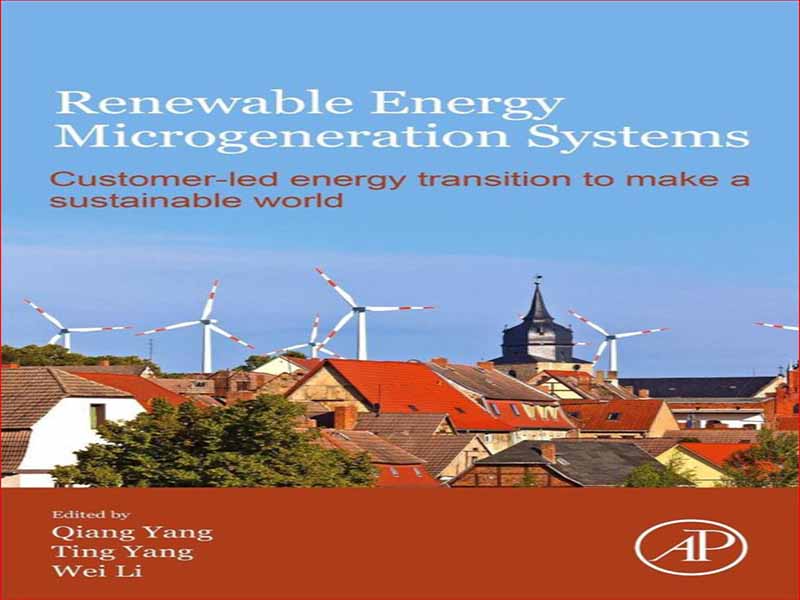- عنوان مجله: Renewable Energy Microgeneration Systems
- نویسنده: QIANG YANG
- حوزه: َانرژیهای تجدید پذیر
- سال انتشار: 2021
- تعداد صفحه: 336
- زبان اصلی: انگلیسی
- نوع فایل: pdf
- حجم فایل: 15.1 مگابایت
در توسعه زیرساختهای شبکه هوشمند در سراسر جهان، تولید میکرو توجه فوقالعادهای را به خود جلب کرده است. تولید ریز به طور کلی به سیستمهای مقیاس کوچکی اطلاق میشود که برق و/یا گرما را برای خانههای خانگی تولید میکنند، برای مثال، کلکتورهای حرارتی خورشیدی که آب گرم و پانلهای فتوولتائیک پشت بام را برای تولید برق، به عنوان جایگزین یا مکمل برای برق متمرکز متصل به شبکه فراهم میکنند. سودمندی اگرچه ریزتولید با تعاریف مختلفی تفسیر می شود که از کشوری به کشور دیگر متفاوت است، ویژگی های کلیدی این سیستم های تولید انرژی محلی در مقیاس کوچک این است که تولید ریزانرژی به صورت محلی برای مشتریان رخ می دهد و شامل تولید گرما یا برق یا هر دو می شود. در مقایسه با نیروگاه های متمرکز، مقادیر کمی انرژی تولید می کند. در بریتانیا، ریز تولید به عنوان تولید برق تا 50 کیلووات و/یا گرمای تا 45 کیلووات از منبع کم کربن تعریف می شود. تولید ریز شامل اشکال مختلف تولید انرژی است: الکتریسیته (مانند فتوولتائیک خورشیدی، میکروبادی، میکروهیدرو، میکرو-CHP و سلول های سوختی) و گرما (به عنوان مثال، حرارت خورشیدی، پمپ های حرارتی منبع هوا، پمپ های حرارتی منبع زمینی، آب- منبع پمپ های حرارتی، اجاق های زیست توده، و دیگهای بخار). به طور مؤثری ریز تولید به مصرفکنندگان این امکان را میدهد تا در رسیدگی به انتقال انرژی در سراسر جهان پیشتاز باشند و ممکن است مقدار انرژی را که باید خریداری کنند کاهش دهد و در نتیجه از فقر انرژی بهویژه در کشورهای در حال توسعه جلوگیری کند.
In the development of smart grid infrastructure across the world, microge- neration has received tremendous attention. Microgeneration generally refers to the small-scale systems that generate electricity and/or heat for domestic dwellings, for example, solar thermal collectors providing hot water and rooftop photovoltaic panels for electricity generation, as alterna- tives or supplements to the centralized grid-connected power utility. Although the microgeneration is interpreted with different definitions that vary from country to country, the key characteristics of these small-scale local energy generation systems are that the microenergy generation occurs locally to the customers and includes the generation of heat or electricity or both, and it generates small amounts of energy compared with centralized plants. In the United Kingdom, microgeneration is defined as the generation of electricity of up to 50 kW and/or heat of up to 45 kW from a low-carbon source. The microgeneration includes different forms of energy generation: electricity (e.g., solar photovoltaics, microwind, microhydro, micro-CHP, and fuel cells) and heat (e.g., solar thermal, air-source heat pumps, ground- source heat pumps, water-source heat pumps, biomass stoves, and boilers). Effectively the microgeneration empowers consumers to take the lead in addressing the energy transition across the world and may reduce the amount of energy they have to purchase and thus preventing energy pov- erty, particularly in developing countries.
این کتاب را میتوانید از لینک زیر بصورت رایگان دانلود کنید:
Download: Renewable Energy Microgeneration Systems



































نظرات کاربران